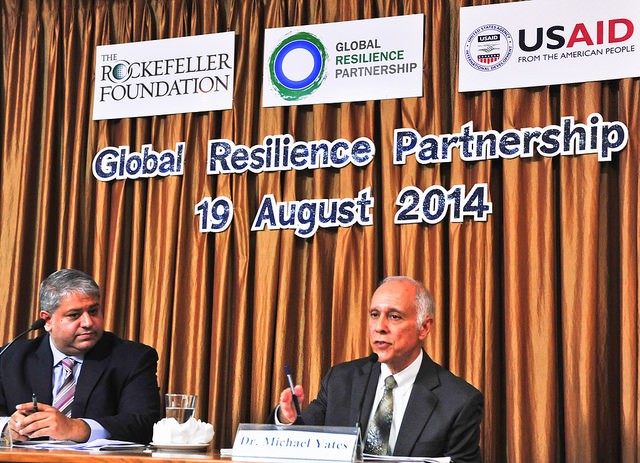
As we know recurrent crises affect countries around the world, and last year alone killed more than 20,000 people. Today we are focusing on Asia, and I will briefly provide some relevant data points to help set the stage for our discussion.
First, in Bangladesh, rising sea levels threaten to drown one-fifth of the country’s landmass, where 18 million people now reside. In Nepal, over 2 million live on potentially hazardous fault lines, where earthquakes could cause severe damage.
According to the World Bank, $1 out of $3 dollars in development funding is lost as a result of recurrent crises, totaling $3.8 trillion over the last 30 years.
In fact, the number of weather-related disasters has tripled during that same period of time, as has the costs of dealing with them - to $200 billion each year.
The year 2013 was the year with the most disasters, but we know that with increasing population growth, and the increasing impacts of climate change, more and more people will be put in harm's way - in the region’s rapidly growing cities, and especially in low-lying coastal areas.
We also know that unsustainable patterns of natural resource use can exacerbate these problems, from clearing mangroves that protect communities against storm surges, to felling forests that reduce erosion and protect vital water sources.
Of course we know we can’t prevent typhoons or earthquakes, but we can work smarter to minimize impacts on families and communities, and to prevent serious setbacks on hard-won development gains. And we know that to reach our goal of eradicating extreme poverty by 2025, we have to ensure that even the world’s most vulnerable people are better prepared to stay on track to development.
The trend with crises worldwide is clear, and deeply disturbing. Simply put, we need to be smarter in making our investment decisions, whether as development professionals, city planners, community leaders, or representatives of the private sector -- or indeed, as any and all stakeholders working on building economic enterprise and social growth.
And we need to do it now.
Just one final data point: by 2025, or in just about 10 years, it is estimated that more than 400 million people will likely be vulnerable to flooding in Asia -- and with that, could potentially be driven deeper into poverty, with loss of key assets and livelihoods, and with increased incidence of disease. Disasters bring multiple problems, in many sectors.
But it really doesn't have to be that way - we can choose a different path. One in which we work to find ways, together, to better manage risk.
For example, imagine that the rapid urbanization we are all witnessing in Asia’s small and medium-sized cities is coupled with sound urban planning, and disaster-
resistant infrastructure.
Imagine smart zoning, with good building codes and standards; solid hospitals, schools, roads, ports, and communications infrastructures; and better natural resources management. Imagine early warning systems in place in all areas prone to risk, to alert all segments of society of approaching threats.
We do have a choice. We can either face a future that is constantly vulnerable to disasters and seemingly unbreakable cycles of poverty... or we can manage our risks smartly and minimize losses, while also fostering a secure environment in which social and economic progress can take place. In a manner of speaking, we can repair the roof on our collective houses before it rains, rather than pay for all the damage that a leaking roof can mean later.
That's why we are here today, to encourage smarter decisions, and we want to share with you a new initiative that we believe will help, called the Global Resilience Partnership. By drawing on the relative strengths of our two organizations, USAID and the Rockefeller Foundation hope to help the global community be increasingly more proactive before disasters strike.
Our partnership, announced by the USAID Administrator and Rockefeller Foundation President at the African Leaders Summit in Washington just a couple of weeks ago, promotes resilience in three geographic regions: South and Southeast Asia, the Sahel and the Horn of Africa. I know I speak for my good colleague from the Rockefeller Foundation when I say that we are both proud to announce it today, in Asia.
With an initial commitment of $100 million, the Resilience Partnership will help identify, scale-up and accelerate promising approaches; unlock new partnerships; and enhance the collective efforts of all to build resilience. We know that $100 million is a relatively small amount across these regions, but we also know that -- strategically targeted -- these resources can play an important catalytic role, and encourage others to join in. By building networks and engaging more stakeholders across sectors -- businesses, civil society, local governments, academic and scientific institutions, and more, we can have real impact. Working together, we can make smarter investments that save countless lives and livelihoods.
You will hear us using the term "resilience" repeatedly today. Essentially, it means this: when confronted with shocks, like typhoons and earthquakes, and stressors, like climate change or changing disease patterns, people are able to take effective action to avoid major losses and preserve their abilities to rebound and get back on track. Resilience is essential if we are to win the fight against poverty, and ensure that no segments of society are left behind.
The vision for resilience is front and center in USAID's agenda. Both USAID and the RF see resilience as a vital framework to help alleviate poverty and promote more sustainable development, lessening the impacts of disasters. We can choose a better, and smarter, future.
That will take creativity, innovation, and cross-sectoral partnerships, and we are pleased to be able to support this most important effort.







Comment
Make a general inquiry or suggest an improvement.